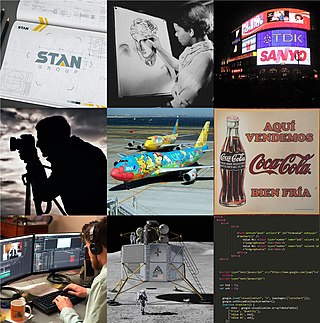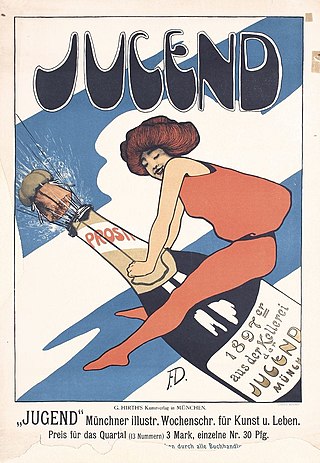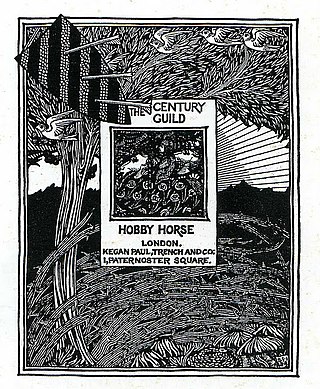
Graphic design is a profession, academic discipline and applied art whose activity consists in projecting visual communications intended to transmit specific messages to social groups, with specific objectives. Graphic design is an interdisciplinary branch of design and of the fine arts. Its practice involves creativity, innovation and lateral thinking using manual or digital tools, where it is usual to use text and graphics to communicate visually.

Typography is the art and technique of arranging type to make written language legible, readable and appealing when displayed. The arrangement of type involves selecting typefaces, point sizes, line lengths, line spacing, letter spacing, and spaces between pairs of letters. The term typography is also applied to the style, arrangement, and appearance of the letters, numbers, and symbols created by the process. Type design is a closely related craft, sometimes considered part of typography; most typographers do not design typefaces, and some type designers do not consider themselves typographers. Typography also may be used as an ornamental and decorative device, unrelated to the communication of information.

Printing is a process for mass reproducing text and images using a master form or template. The earliest non-paper products involving printing include cylinder seals and objects such as the Cyrus Cylinder and the Cylinders of Nabonidus. The earliest known form of printing evolved from ink rubbings made on paper or cloth from texts on stone tablets, used during the sixth century. Printing by pressing an inked image onto paper appeared later that century. Later developments in printing technology include the movable type invented by Bi Sheng around 1040 and the printing press invented by Johannes Gutenberg in the 15th century. The technology of printing played a key role in the development of the Renaissance and the Scientific Revolution and laid the material basis for the modern knowledge-based economy and the spread of learning to the masses.

Piet Zwart was a Dutch photographer, typographer, and industrial designer.

F+W was a media and e-commerce company headquartered in New York City. Founded in 1913 in Cincinnati, F+W published magazines, books, digital products, produced online video, offered online education, and owned and operated e-stores, as well as consumer and trade shows.

Rudolf Koch was a German type designer, professor, and a master of lettering, calligraphy, typography and illustration. Commonly known for his typefaces created for the Klingspor Type Foundry, his most widely used typefaces include Neuland and Kabel.

Guity Novin is an Iranian-born Canadian artist, known as a figurative painter and graphic designer. She classifies her work as "transpressionism", a term coined by Novin in the 1990s. Her works are in private and public collections worldwide. Novin has served on a UNESCO national committee of artists.
JazzTimes was an American print magazine devoted to jazz. Published 10 times a year, it was founded in Washington, D.C., in 1970 by Ira Sabin as the newsletter Radio Free Jazz to complement his record store.
William Edwin Rudge is the name of a grandfather, father and son, all of whom worked in the printing business. It's also the name of their business.
Vincent Brooks, Day & Son was a major British lithographic firm most widely known for reproducing the weekly caricatures published in Vanity Fair magazine. The company was formed in 1867 when Vincent Brooks bought the name, good will and some of the property of Day & Son Ltd, which had gone into liquidation that year. The firm reproduced artwork and illustrations and went on to print many of the iconic London Underground posters of the twenties and thirties before being wound up in 1940.

Jugend (1896–1940) was an influential German arts magazine. Founded in Munich by Georg Hirth who edited it until his death in 1916, the weekly was originally intended to showcase German Arts and Crafts, but became famous for showcasing the German version of Art Nouveau instead. It was also famed for its "shockingly brilliant covers and radical editorial tone" and for its avant-garde influence on German arts and culture for decades, ultimately launching the eponymous Jugendstil movement in Munich, Weimar, and Germany's Darmstadt Artists' Colony.

The Hobby Horse was a quarterly Victorian periodical in England published by the Century Guild of Artists. The magazine ran from 1884 to 1894 and spanned a total of seven volumes and 28 issues. It featured various articles not only on arts and design but other subjects including literature and social issues as well. It also featured artwork such as sketches, plates, photographs, engravings, wood cuts, lithographs and reproduced paintings.
Dennis Ichiyama is an artist focusing on woodblock prints and former professor of Visual Communications Design at Purdue University in West Lafayette, Indiana..

Active Interest Media (AIM) is a publisher specializing in "niche enthusiast magazines".

Henri Friedlaender (1904–1996) was an Israeli typographer and book designer. He co-founded the Hadassah Printing School and served as the first director of the school.

Alan Kitching RDI AGI Hon FRCA is a practitioner of letterpress typographic design and printmaking. Kitching exhibits and lectures across the globe, and is known for his expressive use of wood and metal letterforms in commissions and limited-edition prints.

Kit Hinrichs is an American graphic designer, author, collector, and design educator.

Bibliography of early American publishers and printers is a selection of books, journals and other sigmass devoted to these topics covering their careers and other activities before, during and after the American Revolution. Various works that are not primarily devoted to those topics, but whose content devotes itself to them in significant measure, are sometimes included here also. Works about Benjamin Franklin, a famous printer and publisher, among other things, are too numerous to list in this bibliography, can be found at Bibliography of Benjamin Franklin, and are generally not included here unless they are intensely devoted to Franklin's printing career. Single accounts of printers and publishers that occur in encyclopedia articles are not included here.
Ricardo "Rick" Griffith is a British graphic designer and master letterpress printmaker of West Indian descent. One of Griffith's best-known contributions to letterpress printmaking is annotation, and his most famed work is the poster “Introductory Ethic for Designers.” Griffith was PRINT Magazine's first Artist-in-Residence. He owns and operates MATTER, a design studio, typography laboratory, and design bookstore, which was the first Black-owned bookstore in Colorado. Griffith founded the Black Astronaut Research Project (BLARP.org). As a designer, art director, master letterpress printmaker, writer, curator, educator, lecturer, and activist, Griffith works to create and disseminate graphics geared towards dismantling white supremacy and racism in the interest of reparative justice.














